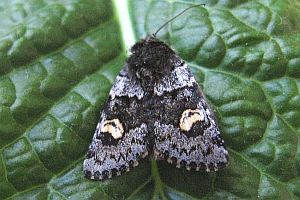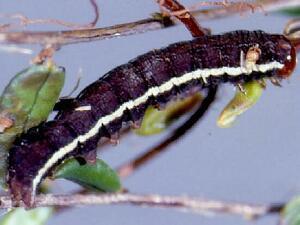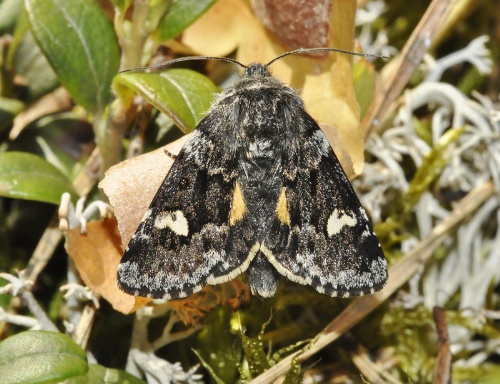Coranarta cordigera
Moor - Bunteule ( Coranarta cordigera )
The Moor - Bunteule ( Coranarta cordigera ) is a butterfly (moth ) from the family of cutworms ( Noctuidae ).
- 6.1 Notes and references
- 6.2 Literature
Features
Butterfly
The wingspan of the moth is about 21 to 26 millimeters. The forewings have a gray -brown to black -brown base color, while the midfield is further obscured. Striking is the white or light yellow -filled kidney blemish, at the edge of a crescent-shaped dark markings can be seen. About the renal blemish on the Costa - are small white or silvery spots. The transverse lines are indistinct. The outer Saumfeld is somewhat brightened, the outer edge dotted alternate black brown and white. The hind wings are bright yellow with a broad, sharply contrasting, black fabric tape and bright fringes. The following color variations have been described:
- F.variegata Tutt. , with gray band in the dark Midfield
- F.suffusa Tutt. , with black forewings and bright fabric tape
- F.aethiops Hoffm. , with plain black front wings
Caterpillar, and chrysalis
The caterpillar is reddish or brownish, has a bright back line and also bright side ridge lines. The lanes are wide, yellowish and black limited upward. The squat doll has two curved thorns on the cremaster.
Similar Species
Similar types are:
- Coranarta carbonaria (Christoph, 1893). How Lafontaine 1987 found out, after a revision of the entire species complex, this kind in Siberia and Central and East Asia is home. All previous cordigera finds from this region were carbonaria in truth. The dark band on the hind wings of the butterfly is very narrow.
- Coranarta restricta ( Yela, 2002), first considered as a variety of cordigera, she was recognized as a distinct species due to differences of the genital system. The dark band on the hind wings is of moderate severity. The species occurs on the Iberian Peninsula. It needs to be further investigated whether the indigenous to the Balkans animals are also restricta Act. The people living in the higher regions of the Balkans Animals are certainly real cordigera.
In addition to the different width of the Saumbänder of the hind wings, the species must be distinguished due to the different geographical occurrence.
Superficially similar to the heather - Bunteule ( Anarta Myrtilli ) of the Moor - Bunteule, but is Myrtilli colorful, reddish and high-contrast drawn with clear shaped cross- lines, white spot between the ring and kidney blemish as well as a broader dark band on the hind wings and a black center on the back.
Geographical distribution and habitat
The Moor - Bunteule comes in parts of Europe, mainly in the north, before. In Central and Southern Europe the incidence is confined to the higher mountains. In the Alps, it rises to 2,200 meters. The species is characteristic of peat bogs and marshy wetlands.
Way of life
The species is univoltine, meaning it only one generation per year will be created. The moths fly in May and June. They are diurnal, fly preferably in the sunshine in unsteady, low flight and to visit flowers of various plants. They are perennial flyer, so they can be also found far from their actual habitats. In contrast, they were never observed after Meinecke in Baden- Württemberg outside the raised bog habitats. The females lay eggs singly on detached from plants of the food plant. The caterpillars feed on the leaves of various species of blueberry (Vaccinium ), but prefer the bog bilberry (Vaccinium uliginosum ) and live in July and August. The pupae overwinter.
Endangering
The Moor - Bunteule comes in Germany in several states before, can be numerous very limited points, is classified in the Red List of endangered species but as critically endangered (category 1), only in Baden- Württemberg it applies only as endangered ( category 3).










